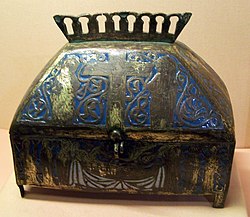Exuperius: Difference between revisions
m Bot: Migrating 6 interwiki links, now provided by Wikidata on d:q1232795 (Report Errors) |
m gen fixes, typos fixed: Sculpure → Sculpture using AWB |
||
| Line 24: | Line 24: | ||
|issues= |
|issues= |
||
}} |
}} |
||
[[File:Basilique Saint-Sernin - Saint Exupère.jpg|thumb| |
[[File:Basilique Saint-Sernin - Saint Exupère.jpg|thumb|Sculpture of Saint Exuperius in the [[Basilica of St. Sernin, Toulouse]].]] |
||
'''Saint Exuperius''' (also '''Exsuperius''') ({{lang-fr|Saint Exupéry, Saint Soupire<ref>[http://www.catholic.org/saints/saint.php?saint_id=3317 St. Exuperius - Catholic Online<!-- Bot generated title -->]</ref>}}) (died c. 410) was [[Bishop of Toulouse]] at the beginning of the 5th century. |
'''Saint Exuperius''' (also '''Exsuperius''') ({{lang-fr|Saint Exupéry, Saint Soupire<ref>[http://www.catholic.org/saints/saint.php?saint_id=3317 St. Exuperius - Catholic Online<!-- Bot generated title -->]</ref>}}) (died c. 410) was [[Bishop of Toulouse]] at the beginning of the 5th century. |
||
| Line 35: | Line 35: | ||
Exuperius was early venerated as a saint. Even in the time of [[Gregory of Tours]] he was held in equal veneration with [[Saturnin|Saint Saturninus]]. His feast occurs on 28 September. The first martyrologist to assign it to this date was [[Usuard]], who wrote towards the end of the 9th century. |
Exuperius was early venerated as a saint. Even in the time of [[Gregory of Tours]] he was held in equal veneration with [[Saturnin|Saint Saturninus]]. His feast occurs on 28 September. The first martyrologist to assign it to this date was [[Usuard]], who wrote towards the end of the 9th century. |
||
== |
==Sources== |
||
{{catholic}} |
{{catholic}} |
||
Revision as of 06:23, 22 May 2013
- For other uses, see Exuperius (disambiguation).
Saint Exuperius | |
|---|---|
 13th century reliquary holding Exuperius' relics. Musée Paul Dupuy, Toulouse. | |
| Bishop | |
| Born | unknown |
| Died | c. 410 |
| Major shrine | Toulouse |
| Feast | 28 September |

Saint Exuperius (also Exsuperius) (French: Saint Exupéry, Saint Soupire[1]) (died c. 410) was Bishop of Toulouse at the beginning of the 5th century.
His place and date of birth are unknown. Upon succeeding Saint Sylvius as bishop of Toulouse, he completed the Basilica of St. Sernin, begun by his predecessor. Saint Jerome praises him for his munificence to the monks of Palestine, Egypt, and Libya, and for his charity to the people of his own diocese, who were then suffering from the attacks of the Vandals, Alans, and Suevi. For the sake of the poor in his diocese he even sold the altar vessels and so was compelled to carry the Sacred Offering in an osier basket and the Precious Blood in a vessel of glass. In esteem for his virtues and in gratitude for his gifts, Saint Jerome dedicated to him his Commentary on Zacharias.
Exuperius is best known in connection with the Canon of the Sacred Scriptures. He had written to Innocent I for instructions concerning the canon and several points of ecclesiastical discipline. In reply, the pope honoured him with the letter Consulenti tibi, dated February 405, which contained a list of the canonical scriptures as they are today.[2]
The opinion of Baronius, that the bishop Exuperius was identical with the rector of the same name, is quite generally rejected, as the rector was a teacher of Hannibalianus and Dalmatius, nephews of Constantine the Great, over a half a century before the period of the bishop. From Jerome's letter to Furia, in 394, and from the epistle of Saint Paulinus to Amandus of Bordeaux, in 397, it seems probable that Exuperius was a priest at Rome, and later at Bordeaux, before he was raised to the episcopate, though it is possible that in both of these letters reference is made to a different person. Just when he became bishop is unknown. That he occupied the See of Toulouse in February 405, (as is evident from the letter of Innocent I mentioned above) and from a statement of Saint Jerome in a letter to Rusticus it is certain that he was still living in 411. It is sometimes said that Jerome reproved him, in a letter to Riparius, a priest of Spain, for tolerating the heretic Vigilantius; but as Vigilantius did not belong to the diocese of Toulouse, Jerome was probably speaking of another bishop.
Exuperius was early venerated as a saint. Even in the time of Gregory of Tours he was held in equal veneration with Saint Saturninus. His feast occurs on 28 September. The first martyrologist to assign it to this date was Usuard, who wrote towards the end of the 9th century.
Sources
![]() This article incorporates text from a publication now in the public domain: Herbermann, Charles, ed. (1913). Catholic Encyclopedia. New York: Robert Appleton Company.
This article incorporates text from a publication now in the public domain: Herbermann, Charles, ed. (1913). Catholic Encyclopedia. New York: Robert Appleton Company. {{cite encyclopedia}}: Missing or empty |title= (help)
References
- ^ St. Exuperius - Catholic Online
- ^ including the deuterocanonical books of the Catholic Canon. The assertion of non-Catholic writers that the Canon of Innocent I excluded the Apocrypha is not true, if they mean to extend the term "Apocrypha" to the deuterocanonical books.
